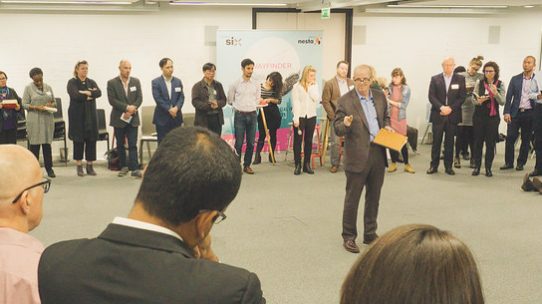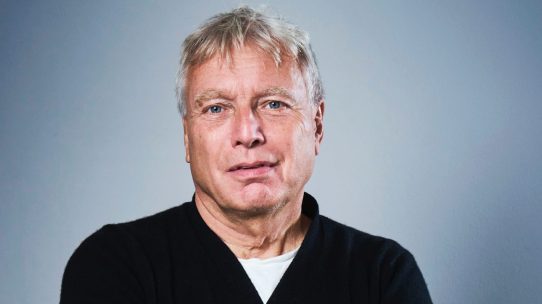The short answer is yes. And it matters because it offers a structured, collective and increasingly recognisable way of thinking about and working on some of the world’s most difficult challenges, solutions to which impact the quality of people’s lives and the strength of our economies and societies.
It’s an old idea and a new and evolving practice.
Ever since there’s been “social” (which is pretty much as long as we’ve been here), there’s been “social innovation”.
The defining characteristic of humans is our innate desire to be with other humans. We are, as the philosophers, poets and scientists keep reminding us, social creatures. And, despite our persistent capacity to sometimes do it very badly (think war, racism, bickering neighbours) we strive always to engage and connect with others to live well (think street parties, any number of the world’s great social movements for change ad reform, choirs, raising barns).
In fact, there are plenty of explanations of what makes humans special and distinct that settle on the capacity for social or collective action – our ability to communicate, organise and collaborate – as the ultimate source of human ingenuity, prosperity and resilience.
And because we are by definition social, we have been social innovators by instinct, by preference and by long, often arduous and occasionally brilliant practice. We’ve invented new ways to collaborate and make common cause for shared outcomes (think government, communes, street parties, sporting teams, organisations) and we’ve got together in many different ways and at very different scales to come up with better ways to tackle many social challenges (think eradicating disease, fighting poverty, new models of aged care and better ways to give people with disabilities a chance at life in full).
When you think about it, human history is the history of social innovation defined as the constant search – small, big, incremental, breakthrough, but always on the assumption that we go further together – to find better ways for us to live together well and to tackle the things that holds us back – poverty and inequality, disease, isolation and loneliness, the search for care and compassion.
Social innovation is social by instinct and practice. It’s collective, increasingly global and connected and thrives on the same instincts for collaboration and solidarity which it seeks to entrench deep in our societies and across our individual and shared economies.
And it’s a practice to which Australia had been making its distinctive contribution for a long time fired by an instinct to innovate and experiment locally, nationally and often internationally too.
Social innovation matters more than ever.
Social innovation is social, it’s economic and it’s about the quality and resilience of democracy. When it works, the payoff is big.
So many of the big, difficult and consequential problems which beset humans across the world are social – persistent inequality and poverty, disease, loneliness, discrimination, injustices in many and complex forms, forms of governing that too often turn to oppression and fear.
In Australia’s case, we could add the chronic inability to “close the gap” between the life chances and experiences of many Aboriginal and Torres Strait Islander people and the rest of the population.
And these things matter more than ever for three reasons.
Firstly, they are intrinsically important because they impact the lives of millions of people. Failure to tackle them means lives diminished or lost.
Secondly, these things are not just social challenges but economic challenges too. Lifting productivity, skilling a well-educated, confident and capable workforce to do satisfying work in a dramatically shifting digital economy, building and fairly sharing wealth through work, investment and innovation are all solid economic policy agenda items.
But their solution has never been purely economic. At the heart of any sustainable response to that cluster of imperatives, and many others are people and their ability to learn, live well, be treated fairly, stay well and healthy, connect and collaborate and govern themselves with a sense of fairness and accountability.
Thirdly, these things matter because they play into the biggest question of the moment – whether we can fashion, defend and improve the practices and reflexes of co-operation and community that fuel democracy itself.
If that is true, then the absence of a settled and demonstrably successful social “R&D” capability, working at scale to bring clever ideas from insight to impact in tried and tested rhythms of invention, investment, prototyping and adoption is a real anomaly.
Some areas of focus in my work
In recent years, I’ve worked on a number of projects that speak to the importance and impact of social innovation.
One has been to take a deeper look at patterns and structures of care and caring. How do we evolve the culture, the policy and the practice of care and caring right for a strong and resilient economy and a fair and sustainable society?
How do we make care and caring more systematically human for a strong and resilient economy and a fair and sustainable society? And how can we make sure that relationships, dignity and agency infuse our culture and institutions of public governance and social action?
I’ve also been working recently with a growing group of people clustering around the idea of relational care. In particular, the new Centre for Relational Care is building momentum, with a growing group of people and organisations, for a big reset in the way we ‘do’ care.
It’s the core of a movement committed to transforming child protection and out-of-home care in Australia to a child connection system that places relational care at its heart. It’s leading the development of practical, alternative solutions to existing care systems, guided by evidence that underscores the effectiveness of attachment and relational security.
I’m also part of The Possibility Partnership, a project started by a few senior leaders from some of Australia’s largest NGO human service providers, with a particular take on human services systems change. The idea focuses on one particular dimension of the way the human services system works that if we could find a way to improve its role and contribution, could prove to be a big lever for more effective systems change.
That piece is the ‘connecting middle’. It’s the part which connects those people and interests responsible for defining and enforcing the rules and processes of the human services system on the one hand and, on the other the expertise and insights of those people working in specific communities and with particular people on the ground.
That should be a process of open, continuous and mutual learning. For the most part, that ‘connecting middle’ experience is frustrating, slow and cumbersome and very often doesn’t happen at all.
Make that process simpler, more predictable, more effective as part of a genuinely mutual learning and influence approach and the rate at which the larger system will then shift in accordance with the kinds of outcomes that people throughout the system want and are trying so hard to achieve will start to happen because of, and not in spite of the system.






